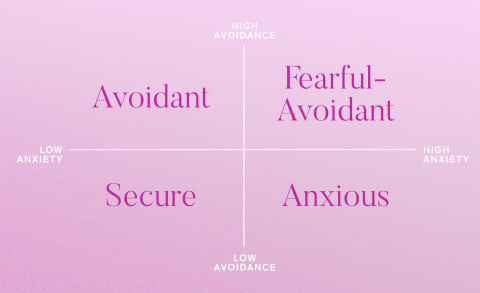Here’s everything you need to know about the four attachment styles, how they’re formed in childhood, and how to develop a secure attachment style. According to attachment theory, first developed by psychologist Mary Ainsworth and psychiatrist John Bowlby in the 1950s, a person’s attachment style is shaped and developed in early childhood in response to their relationships with their earliest caregivers. Essentially, our adult attachment style is thought to mirror the dynamics we had with our caregivers as infants and children. Attachment style includes the way we tend to respond emotionally to others, how we usually interact with partners in relationships, and how we behave when it comes to relationships in general, according to therapist Alyssa “Lia” Mancao, LCSW. Some research measures the four attachment styles based on an individual’s levels of avoidance and anxiety in relationships, as seen in the chart below: About 56% of adults have a secure attachment type, according to foundational attachment research by social psychologists Cindy Hazan and Phillip Shaver in the 1980s. Secure attachment is considered the healthy ideal for relationships. All other attachment styles that are not secure are known as insecure attachment styles. Anxious attachment is associated with “neediness” or clingy behavior in relationships, such as getting very anxious when your partner doesn’t text back fast enough and constantly feeling like your partner doesn’t care enough about you. Anxious attachment is also known as anxious-preoccupied attachment, and it generally aligns with the anxious-ambivalent attachment style or anxious-resistant attachment style observed among children. Some 19% of adults have the anxious attachment type, according to Hazan and Shaver’s research. In relationships, avoidant people typically maintain some distance from their partners or are largely emotionally unavailable. They may even find relationships suffocating and avoid them completely, preferring to be independent and rely on themselves. Avoidant attachment is also known as dismissive-avoidant attachment, and it generally aligns with the anxious-avoidant attachment style observed among children. Some 25% of adults have the avoidant attachment type, according to Hazan and Shaver. Fearful-avoidant attachment is also known as disorganized attachment, because the attachment behaviors display by these individuals can seem inconsistent and oscillate between the extremes of avoidance and anxiousness. In general, the fearful-avoidant attachment style is relatively rare and not well-researched. But we do know it’s associated with significant psychological and relational risks1, including difficulty regulating emotions, heightened sexual behavior, and increased risk for violence in their relationships. Here are two more attachment style quiz options to try: “Human beings are born helpless, so we are hardwired at birth to search for and attach to a reliable caregiver for protection,” Peter Lovenheim, author of The Attachment Effect, writes at mbg. “The quality of that first bond—loving and stable or inconsistent or even absent—actually shapes the developing brain, influencing us throughout life in how we deal with loss and how we behave in relationships.” Here’s a quick primer on what circumstances lead to each of the four attachment types: It’s also possible to have a different attachment style in different situations, according to Mancao. “While we may have a primary attachment style, depending on our relationships, we may feel more secure with one person than we do with another,” she explains. “For many people, their attachment style is not the same in every relationship they encounter. Things that contribute to this are their counterpart’s (romantic or platonic) personality and feelings of safety.” Mary Ainsworth, a psychologist and one of Bowlby’s colleagues, expanded on Bowlby’s original attachment theory by identifying individual differences in how infants handled separations from their parents. Her famous “strange situation” experiment in 1969 identified four attachment types among infants: secure, anxious-resistant, avoidant, and disorganized. Later in the 1980s, social psychologists Cindy Hazan and Phillip Shaver began to apply Ainsworth and Bowlby’s attachment theory to adult romantic relationships, giving birth to the concept of the adult attachment styles we know today. In 1998, research psychologist Kelly Brennan and her colleagues further expanded on adult attachment, demonstrating two distinct dimensions that shape attachment patterns: attachment-related anxiety and attachment-related avoidance. People can be low in both, high in one and low in the other, or high in both, which determines their attachment style. (See above graphic.) Today, there’s some criticism of attachment theory among psychologists who say it’s a stretch to believe caregivers can so dramatically shape infants’ future relationships from such a young age. Indeed, thus far, studies attempting to draw a line between infant attachment patterns and their adult attachment styles have only found “small to moderate” correlations, according to Fraley himself. “Based on these kinds of studies, it seems likely that attachment styles in the child-parent domain and attachment styles in the romantic relationship domain are only moderately related at best,” Fraley writes in a University of Illinois article. But the concept of attachment styles is enduring for a reason: It gives people language to describe the distinct ways they show up in their relationships, and it challenges them to look to their past experiences to help them understand why they are the way they are. Here are some of the patterns they observed: “Assess your current and past attachment style and identify if there are any patterns in choosing romantic partners,” Suh says. “Be aware of your childhood history; the familiarity is comforting, whether it was good or bad. Meaning, your past unhealthy relationship patterns from childhood can recreate in adulthood.” “Learn to embrace, value, love, and care for yourself first,” she recommends. “If you cannot fathom what self-love is because you were neglected, abused, and dismissed as a child, you can start with self-tolerance and self-neutrality. This can look like, ‘I’m a person, and everyone deserves to be valued’ instead of forcing yourself with empty words of, ‘I’m beautiful and valuable.’” (Here’s more on learning to love yourself, plus how to raise your self-esteem after a breakup specifically.) “Learn to be assertive and set boundaries. Honor what you feel, and express your needs in words without manipulation and hidden meanings,” Suh says. “Securely attached people are often direct and appropriately confrontational to create a healthy and meaningful relationship.” With her warm, playful approach to coaching and facilitation, Kelly creates refreshingly candid spaces for processing and healing challenges around dating, sexuality, identity, body image, and relationships. She’s particularly enthusiastic about helping softhearted women get re-energized around the dating experience and find joy in the process of connecting with others. She believes relationships should be easy—and that, with room for self-reflection and the right toolkit, they can be. You can stay in the loop about her latest programs, gatherings, and other projects through her newsletter: kellygonsalves.com/newsletter






